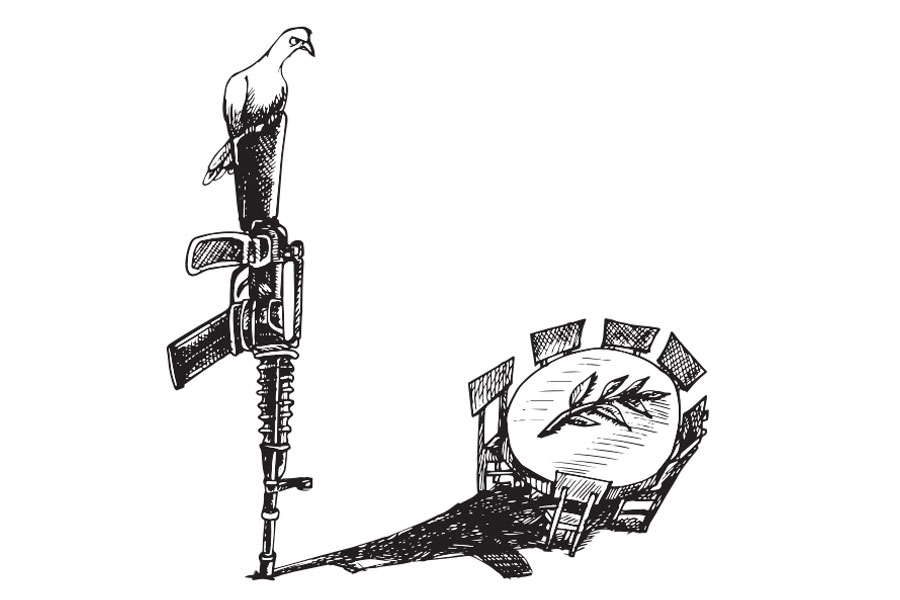
Editorial | Feb 08,2020
A tale of the mediaeval town began with an intriguing trip about a decade ago.
The destination was the long-forgotten town in Amhara Regional State, lest a rich history as a seat for the Shoan dynasty and a trade route along the east-west crossroads: Ankober Palace.
I was fortunate to experience firsthand the aesthetics of the town and its enthralling history through the expedition organised by 'Keep Fit', a UNECA staff health club, with nearly 80 passengers of diverse origins.
As the bus traversed the winding highway, the scenery of rural Ethiopia unfolded. It was the farthest north I have travelled. I noted a reminder of the importance of taking a break from the chaos of city life and appreciating the tranquilly of the natural world.
While in transit, we reposed at Debre Berhan town. It is known for the famous alcoholic drink Areqe and textile industry producing high-quality woollen blankets from locally bred sheep. For a place distinct to have a cold highland climate sitting at an altitude of 2,800mt, it embraced us with relatively warm weather.
The bus made a stop at Getva Hotel, owned by the long-distance runner, Getie Wami, as a launch pad for the treacherous gravel road ahead. The delicious meal lived up to the Hotel's reputation amid the aroma of roasted coffee beans and the enchanting scents of incense and myrrh.
As we resumed the journey, I witnessed the negative impact of eucalyptus trees on the environment, with depleted soil and limited access to groundwater. Farming in the area still relied heavily on seasonal rainfall.
Eventually, we arrived at the base of Ankober Palace, 175Km away from the capital. The hike to climb up the hill was a challenging yet rewarding experience, providing a glimpse into the daily lives of the locals and their impressive physical abilities. I still recall a young woman carrying a bag of grains, looking back compassionately at our miserable faces and the rolls of sweat on our foreheads on a steep climb. Once she was sure we had reached the top, she climbed the hill with superhuman agility and speed while still carrying about 25–30Kg.
Despite the physical toll it took on us, the exceptional adventure was filled with breathtaking views and encounters with the locals who effortlessly navigated the terrain while we struggled to keep up. It was a reminder of the physical limitations that come with living a sedentary lifestyle in the city.
The famed Ankober Palace & Lodge was perched at the foothill. A welcome squad provided us with wooden walking canes, signalling continuance. That only added to our sense of trepidation, but determination was the ultimate driving force. In spite of our initial apprehension, we took on the challenge and began our ascent up the hill towards the lodge. Turning back was no option while we were close to our destination. We bravely set out on what would prove to be the most challenging part of the adventure as the experience brought us closer together.
The hill's sharp turns and lack of oxygen made the trek difficult. Every step demanded effort, huge physical exertion and a strong mental resolve. Despite the challenges, the group persevered and eventually reached the summit. The breathtaking view from the top made it all worth it, and we felt a sense of accomplishment and pride in ourselves. The journey was tough; previous wounds resurfaced, but the memories and experiences gained will stay with them forever.
We eventually arrived at the narrow plateau near the summit with the sighting of the Ankober Lodge, about seven bungalows strewn on the slopes. The palace was in excellent condition and had wooden structures, balconies in the traditional style and thatched roofs. The dining hall walls are covered with ancient portraits and traditional relics.
One of the guides explained how protection from enemy armies required holding a higher and inaccessible position with a 360-degree view of the surrounding area. Inhabiting high-altitude plateaus by building a fortress was common in the tumultuous history of mediaeval warfare. The people settled in clusters of houses surrounded by grazing fields and farming land.
Ankober Palace was spectacular.
We were treated to a far sight into the adjacent Afar lowlands. The green highlands were breathtaking, with hill after hill stretching as far as the eye can see, accentuated by an open expanse of amber-coloured lowlands. Apart from a window view, onboard a jetliner at 37,000ft in altitude.
After the meal came the birile of Tej, a traditional honey-based alcoholic drink. I was not a fan. However, the one at the palace left everyone asking for another round, which, sadly, was unavailable.
It was congruent with Rahel Yohannes’ music 'Menelik,' where Queen Taytu’s skills at making Tej were explained, and its odours still lingered in Ankober Palace was narrated. Poetic licence aside, the lyrics meant a lot for someone like me that was experiencing it firsthand.
We drove back while dancing to the music on the bus stereos when twilight came upon the rolling hills. The voyage from UNECA compounds to the palace is an unforgettable event I often reminisce about.
The beautiful sceneries and the joyous revelries of our shared humanity were a humbling experience to witness how effortlessly a simple objective would be unifying.
Despite its glorious history, Ankober's relevance dwindled over time. But the song resonates with the distant past, as Ankober resonates with me as a memorable time in my life.
PUBLISHED ON
Jun 10,2023 [ VOL
24 , NO
1206]


Editorial | Feb 08,2020

Fortune News | Jul 21,2024

Fortune News | Oct 02,2021

View From Arada | Aug 27,2022

Editorial | Nov 07,2020

Life Matters | Feb 09,2019

Covid-19 | May 31,2020

Viewpoints | Feb 08,2020

Viewpoints | May 02,2024

Covid-19 | Apr 04,2020

Dec 22 , 2024 . By TIZITA SHEWAFERAW
Charged with transforming colossal state-owned enterprises into modern and competitiv...

Aug 18 , 2024 . By AKSAH ITALO
Although predictable Yonas Zerihun's job in the ride-hailing service is not immune to...

Jul 28 , 2024 . By TIZITA SHEWAFERAW
Unhabitual, perhaps too many, Samuel Gebreyohannes, 38, used to occasionally enjoy a couple of beers at breakfast. However, he recently swit...

Jul 13 , 2024 . By AKSAH ITALO
Investors who rely on tractors, trucks, and field vehicles for commuting, transporting commodities, and f...

Oct 11 , 2025
Ladislas Farago, a roving Associated Press (AP) correspondent, arrived in Ethiopia in...

Oct 4 , 2025
Eyob Tekalegn (PhD) had been in the Governor's chair for only weeks when, on Septembe...

Sep 27 , 2025
Four years into an experiment with “shock therapy” in education, the national moo...

Sep 20 , 2025
Getachew Reda's return to the national stage was always going to stir attention. Once...